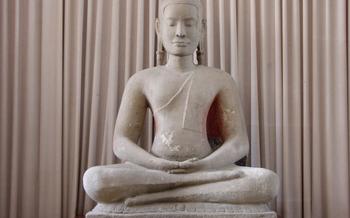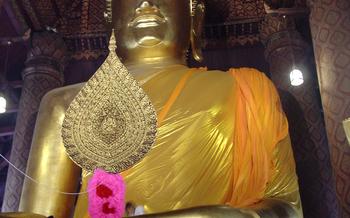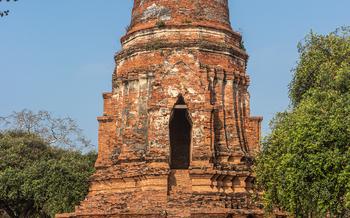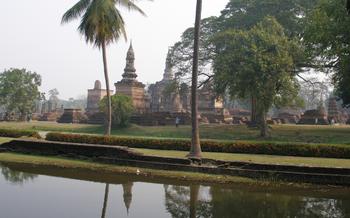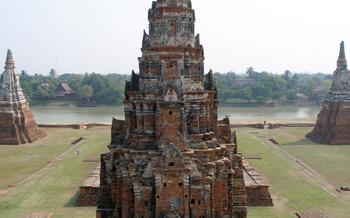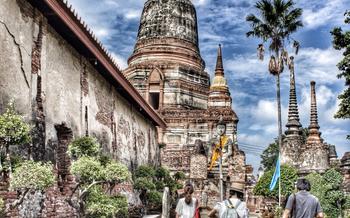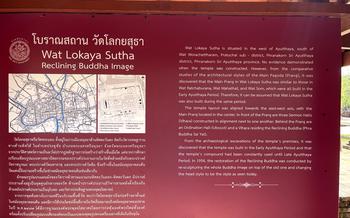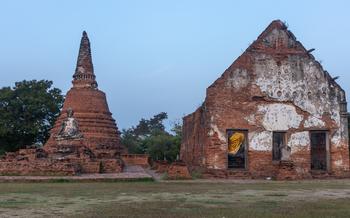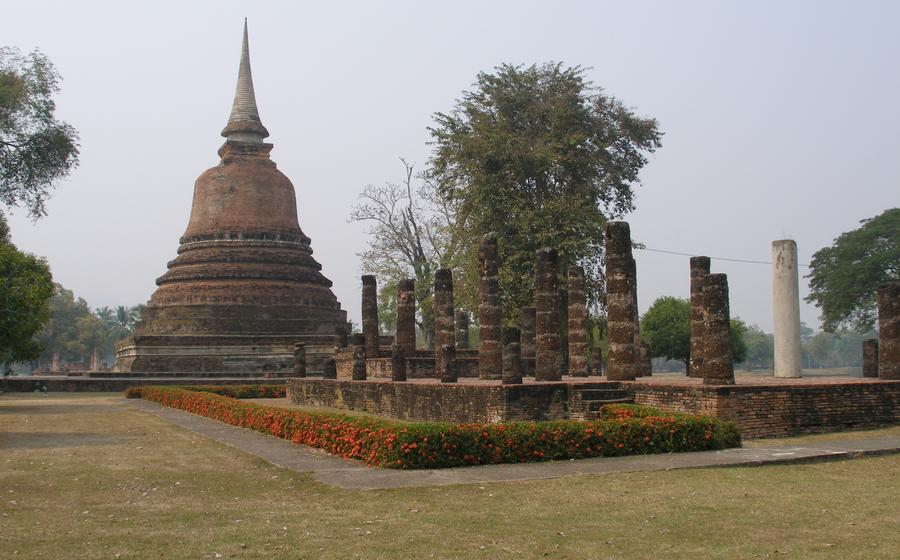
Wat Yai Chai Mongkhon (Ayutthaya)
- Wat Yai Chai Mongkhon: A Grand Ayutthaya Temple
- Location and Accessibility
- Historical Background
- Unique Architecture
- Main Complex and Highlights
- Exploring the Grounds
- Tips for Visitors
- Nearby Attractions
- Wat Yai Chai Mongkhon in Popular Culture
- Festivals and Events
- Local Legends and Folklore
- Wat Yai Chai Mongkhon for History Buffs
- Wat Yai Chai Mongkhon for Spiritual Seekers
- Insider Tip
Wat Yai Chai Mongkhon: A Grand Ayutthaya Temple
Wat Yai Chai Mongkhon, also known as Wat Yai, stands as a testament to the grandeur and artistic achievements of the Ayutthaya Kingdom. Built in the 14th century, this majestic temple complex served as a royal monastery and a spiritual center for the Ayutthayan rulers. Its impressive architectural features, religious significance, and must-see highlights make it a must-visit destination for anyone interested in Thai history, architecture, and spirituality.
Historical Significance
Wat Yai Chai Mongkhon holds immense historical significance as one of the oldest and most important temples in Ayutthaya. Constructed during the reign of King U-Thong, the founder of the Ayutthaya Kingdom, the temple served as a royal monastery and a place for important religious ceremonies. It was also a center of learning and education, where monks and scholars studied Buddhist scriptures and various subjects.
Architectural Features
The temple's striking architectural style reflects the grandeur and opulence of the Ayutthaya Kingdom. The central prang, or main tower, rises majestically above the surrounding structures, symbolizing Mount Meru, the sacred mountain in Buddhist cosmology. The prang is adorned with intricate stucco decorations, sculptures, and ceramic tiles that depict scenes from Buddhist mythology and the life of Buddha.
Religious Importance
Wat Yai Chai Mongkhon holds deep religious significance for Thai Buddhists. It is believed that Buddha's relics are enshrined within the central prang, making it a sacred pilgrimage site for devotees from all over the country. The temple is also home to numerous Buddha images, both ancient and modern, that are revered by the faithful.
Must-See Highlights
Among the must-see highlights of Wat Yai Chai Mongkhon are the following:
- The central prang, with its stunning decorations and symbolic significance.
- The surrounding chapels, which contain exquisite Buddha images and murals.
- The massive reclining Buddha, which is one of the largest in Thailand.
- The ancient bodhi tree, which is believed to be over 500 years old.
- The giant bells, which are rung during important ceremonies and festivals.
Location and Accessibility
Wat Yai Chai Mongkhon is situated in the Ayutthaya Historical Park, a sprawling complex of ancient temples and ruins located in the city of Ayutthaya, Thailand. The exact address of the temple is Wat Yai Chai Mongkhon, Mueang Ayutthaya District, Ayutthaya 13000, Thailand.
Reaching Wat Yai Chai Mongkhon is convenient and accessible. If you're coming from Bangkok, you can take a train or bus to Ayutthaya, which takes approximately 5-2 hours. From there, you can hire a tuk-tuk or bicycle to explore the historical park and visit the temple.
Wat Yai Chai Mongkhon is located about 70 kilometers from Sukhothai, another significant historical city in Thailand. While there is no direct public transportation between the two cities, you can take a train or bus to Phitsanulok and then transfer to another bus or minivan to Sukhothai. From Sukhothai, you can arrange a day trip or guided tour to visit Wat Yai Chai Mongkhon and other attractions in the Ayutthaya Historical Park.
Once you're within the historical park, Wat Yai Chai Mongkhon is easily accessible by foot or bicycle. The temple is well-maintained and surrounded by lush gardens, making it a pleasant and scenic stroll. Along the way, you'll encounter other significant temples and ruins, allowing you to immerse yourself in the rich history and heritage of the Ayutthaya Kingdom.
Historical Background
Wat Yai Chai Mongkhon's construction commenced in the late 14th century during the reign of King Borommaracha I, the founder of the Ayutthaya Kingdom. The temple was built as a symbol of the kingdom's power and prosperity and served as a significant religious and cultural center.
The temple's construction was overseen by the king himself, who was a devout Buddhist and played a crucial role in promoting Buddhism throughout the kingdom. He dedicated the temple to the Buddha and intended it to be a place of worship and pilgrimage for the people of Ayutthaya.
Over the centuries, Wat Yai Chai Mongkhon underwent several renovations and expansions, reflecting the changing needs and tastes of the Ayutthaya Kingdom. During the reign of King Naresuan the Great in the 16th century, the temple was significantly enlarged and embellished, transforming it into one of the most important temples in the kingdom.
Despite the decline and eventual fall of the Ayutthaya Kingdom in the 18th century, Wat Yai Chai Mongkhon survived and remained a sacred site for the local community. It continued to be used for religious ceremonies and festivals, preserving the rich Buddhist heritage of the Ayutthaya period.
Unique Architecture
Wat Yai Chai Mongkhon stands out for its distinctive architectural features, which blend elements of the Ayutthaya and Sri Lankan styles. The temple's most striking characteristic is its massive central prang, which rises majestically above the surrounding structures. The prang features intricate carvings and delicate stucco decorations, showcasing the exceptional craftsmanship of the Ayutthaya period.
The temple's ordination hall, known as the viharn, is another architectural masterpiece. Its elegant design features a multi-tiered roof with graceful gables and sweeping eaves. The interior of the viharn is adorned with vibrant murals depicting scenes from the life of Buddha and the history of the Ayutthaya Kingdom.
Surrounding the central prang and viharn are several smaller chapels and stupas, each with its unique architectural details. These structures add to the temple's overall grandeur and create a harmonious ensemble that reflects the artistic and spiritual achievements of the Ayutthaya period.
The influence of the Ayutthaya Kingdom is evident in the temple's architecture. The use of high spires, intricate carvings, and glazed tiles are all hallmarks of Ayutthaya's architectural style. The temple's design also incorporates elements of Sri Lankan architecture, such as the lotus-bud-shaped stupas and the use of glazed tiles.
The symbolism and motifs found throughout the temple's architecture add to its spiritual significance. The central prang represents Mount Meru, the sacred mountain at the center of the Buddhist cosmos. The surrounding chapels and stupas symbolize the Buddha's teachings and the path to enlightenment. The intricate carvings and decorations depict scenes from Buddhist mythology and history, serving as visual reminders of the temple's religious importance.
Main Complex and Highlights
The heart of Wat Yai Chai Mongkhon lies in its main complex, a striking ensemble of structures that reflect the grandeur of Ayutthaya architecture. The centerpiece of the complex is the towering central prang, a majestic spire that dominates the skyline and draws the eye from afar. Its intricate carvings and elegant lines showcase the exceptional craftsmanship of the era.
Surrounding the central prang are a series of smaller chapels and shrines, each dedicated to a different deity or Buddha image. These chapels are adorned with intricate stucco decorations, colorful murals, and gleaming Buddha statues, creating a vibrant and visually captivating space. Among the most notable Buddha images is the revered Phra Mongkhon Bophit, a colossal bronze Buddha that exudes an aura of serenity and reverence.
Another highlight of the main complex is the impressive assembly hall, or wihan. This spacious hall features a long row of towering Buddha images, each with its unique posture and expression. The walls and ceiling of the wihan are adorned with intricate murals depicting scenes from Buddhist mythology and the life of the Buddha, offering visitors a glimpse into the rich tapestry of Buddhist art and culture.
Exploring the Grounds
The temple's layout follows the traditional Ayutthaya style, with a central prang surrounded by ordination halls, chapels, and smaller stupas. Visitors can wander through the complex, admiring the intricate carvings and architectural details that adorn each structure. The main chapel, or wihan, houses a large Buddha image seated in the meditation posture. The walls of the chapel are adorned with colorful murals depicting scenes from the Buddha's life and teachings.
Within the temple grounds, visitors will find several other notable structures, including a bell tower, a library, and a museum. The bell tower is a tall, slender structure that houses a large bronze bell. The library contains a collection of ancient Buddhist scriptures and manuscripts, while the museum displays artifacts and relics related to the temple's history.
Exploring Wat Yai Chai Mongkhon is a serene and contemplative experience. The temple's peaceful atmosphere and lush gardens provide a tranquil escape from the hustle and bustle of modern life. Visitors can take their time to explore the complex, admiring the architecture, and soaking in the temple's spiritual ambiance.
Tips for Visitors
Wat Yai Chai Mongkhon is a sacred and revered temple, and visitors should adhere to proper etiquette and dress code. Respectful behavior is expected, including refraining from loud noises or disrespectful gestures. Photography is permitted, but it is essential to avoid using flash or posing in inappropriate ways.
To fully appreciate the temple's tranquility and avoid crowds, plan your visit during weekdays or early in the morning. Remember to wear comfortable shoes as you'll be doing a lot of walking on uneven surfaces.
If you're interested in learning more about the temple's history and significance, consider hiring a local guide. They can provide valuable insights and anecdotes, enhancing your overall experience.
Nearby Attractions
Wat Yai Chai Mongkhon is surrounded by a wealth of historical and cultural attractions that further enhance its significance. Within easy reach, visitors can explore the following:
-
Wat Phra Mahathat: Located just a short distance from Wat Yai Chai Mongkhon, this temple is renowned for its iconic central prang and is considered one of the most important historical sites in Ayutthaya.
-
Historical Park: The Ayutthaya Historical Park, a UNESCO World Heritage Site, encompasses a vast expanse of ancient ruins and restored temples, offering a glimpse into the grandeur of the former capital.
-
Ramkhamhaeng National Museum: This museum houses a collection of artifacts and exhibits that shed light on the history and culture of the Ayutthaya Kingdom, including the reign of King Ramkhamhaeng the Great.
-
Night Market: For a vibrant and lively experience, visitors can head to the Ayutthaya Night Market, which offers a diverse array of street food, local handicrafts, and souvenirs.
Wat Yai Chai Mongkhon in Popular Culture
Wat Yai Chai Mongkhon's iconic silhouette and historical significance have made it a popular subject in various forms of popular culture.
-
Films and Documentaries: The temple has been featured in several historical documentaries and films, showcasing its architectural grandeur and religious importance. These productions often explore the history of Ayutthaya and the role of Buddhism in Thai culture.
-
Literature and Art: Wat Yai Chai Mongkhon has inspired numerous works of literature and art, from traditional Thai poetry to contemporary paintings and sculptures. Its unique architecture and serene atmosphere have captured the imagination of artists and writers, who have used the temple as a backdrop for their creative expressions.
-
Symbol of Ayutthaya Heritage: The temple is widely recognized as a symbol of Ayutthaya's rich cultural heritage. Its distinctive prang and surrounding structures have become synonymous with the ancient kingdom, representing the grandeur and artistry of the Ayutthaya people.
-
UNESCO World Heritage Site: Wat Yai Chai Mongkhon's outstanding universal value has earned it a place on the UNESCO World Heritage List. This recognition further solidifies its status as a cultural landmark of global significance, attracting visitors from around the world who seek to experience its historical and architectural wonders.
Festivals and Events
Wat Yai Chai Mongkhon comes alive during festivals and events, showcasing the rich cultural heritage of Ayutthaya. The annual temple fair, held in November or December, is a vibrant celebration with food stalls, games, and traditional performances. During Loy Krathong, the temple grounds are adorned with colorful lanterns and revelers float their krathongs (decorated floats) on the nearby river. Visakha Bucha, the most important Buddhist holiday, is marked with special ceremonies and chanting, attracting pilgrims from across the region. These events offer a unique opportunity to immerse in local traditions and witness the temple's religious significance firsthand.
Local Legends and Folklore
Numerous myths, legends, and historical anecdotes surround Wat Yai Chai Mongkhon, adding to its mystique and spiritual significance. According to local folklore, the temple was built on the site where a sacred Bodhi tree once stood, believed to have been planted by the Buddha himself during his lifetime. It is said that the tree possessed magical powers and granted wishes to those who prayed beneath its shade.
Another legend tells the tale of a young monk named Phra Rachamuni, who is credited with discovering a hidden treasure trove beneath the temple grounds. He used the treasure to build a magnificent golden stupa, which became the centerpiece of the temple complex. The stupa is said to contain relics of the Buddha and is considered a sacred site by devout Buddhists.
The temple is also associated with the legendary King Ramkhamhaeng the Great, the founder of the Sukhothai Kingdom. It is believed that the king visited the temple and made generous donations, contributing to its growth and prosperity. The temple's location near the ancient city of Sukhothai further enhances its historical significance and connection to the kingdom's rich heritage.
Wat Yai Chai Mongkhon for History Buffs
Wat Yai Chai Mongkhon is a treasure trove for history enthusiasts, offering a glimpse into the rich cultural and historical heritage of the Ayutthaya Kingdom. The temple grounds are adorned with ancient inscriptions and artifacts that provide valuable insights into the beliefs, practices, and daily life of the people during that era. These inscriptions, etched on stone tablets, offer a tangible connection to the past and shed light on the temple's history, construction, and significance.
Archaeological excavations conducted at the site have unearthed a wealth of artifacts, including pottery shards, bronzeware, and religious objects, providing further evidence of the temple's long and storied past. These discoveries have helped piece together the history of Wat Yai Chai Mongkhon and contributed to our understanding of the Ayutthaya Kingdom's cultural and religious practices.
History buffs will also appreciate the temple's role as a center of learning and scholarship during the Ayutthaya period. The temple complex once housed a renowned school where monks and scholars studied Buddhist scriptures, history, and philosophy. This educational institution played a crucial role in preserving and transmitting knowledge, contributing to the intellectual and cultural development of the kingdom.
To further enhance the historical experience, visitors can participate in guided tours or attend historical reenactments that bring the past to life. These events showcase traditional ceremonies, cultural performances, and demonstrations of ancient crafts, providing a deeper understanding of the Ayutthaya Kingdom's way of life.
Wat Yai Chai Mongkhon for Spiritual Seekers
For those seeking spiritual enlightenment, Wat Yai Chai Mongkhon offers a serene and sacred space. The temple is an active Buddhist monastery, where monks reside and practice their religious duties. Visitors are welcome to observe the monks' daily routines and learn about Buddhist teachings and practices.
The temple's peaceful atmosphere and beautiful surroundings make it an ideal place for meditation and prayer. Several designated meditation areas are available for visitors to use, where they can find tranquility and focus on their spiritual journey.
The temple also hosts regular religious ceremonies and festivals, which provide a glimpse into the vibrant spiritual life of the local community. Visitors can participate in these ceremonies, make offerings to the Buddha, and receive blessings from the monks.
Whether you are a seasoned meditator or simply seeking a moment of peace and reflection, Wat Yai Chai Mongkhon is a sacred space that welcomes all visitors to explore their spirituality.
Insider Tip
Hidden Gems and Lesser-Known Spots
Beyond the main attractions, Wat Yai Chai Mongkhon holds several hidden gems waiting to be discovered. Explore the serene gardens, where you can find secluded corners to relax and immerse yourself in nature. Look out for the ancient stupas and smaller shrines scattered throughout the grounds, each with its unique history and significance.
Local Food and Dining Options
To savor the local flavors, venture outside the temple complex and explore the nearby streets. You'll find a variety of food stalls and restaurants serving authentic Thai cuisine. Try the delicious boat noodles, a local favorite, or indulge in the sweet and savory treats at the nearby dessert shops.
Best Time to Visit
The best time to visit Wat Yai Chai Mongkhon is during the cooler months from November to February when the weather is pleasant. Avoid visiting during the Songkran festival in April, as the temple grounds can get crowded with water-throwing festivities.
Photography Tips
For photography enthusiasts, Wat Yai Chai Mongkhon offers a wealth of opportunities to capture stunning shots. Arrive early in the morning or late afternoon to take advantage of the soft, golden light. Experiment with different angles to capture the temple's grandeur and intricate details.
Remember to be respectful and mindful when taking photos, especially during religious ceremonies or when people are praying.

